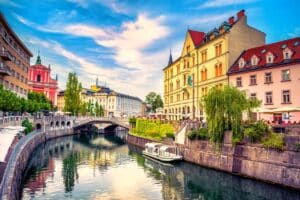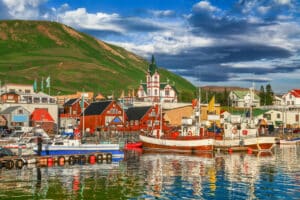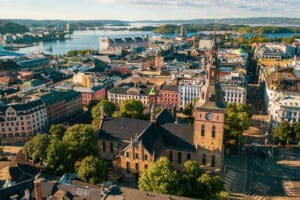Iceland is stunning and unique: the “land of fire and ice” is home to volcanoes and glaciers while fitting into a space smaller than New York at the same time! It boasts few roads and a coastline filled with beautiful fjords stretching over 3,000 miles.
Iceland is home to three national parks, hot springs, active volcanoes, waterfalls, glaciers, and breathtaking views shaped over thousands of years. On top of all that – it’s the safest country in the world.
In the capital, Reykjavik, you’ll find charming places like Harpa, a glass concert hall by the waterfront, Hallgrimskirkja, a tall modern church, and colorful lanes with street art.
Iceland is known for its incredible landscapes, but safety is important when choosing a travel destination. In this article, we share positive news about Iceland’s safety, covering important things to keep in mind.
Are you planning a last minute trip to Iceland? We’ve put together all the resources you’ll need for a fun & safe travel:
🛌 Best & Safest Places to Stay in Iceland:
👉 The Reykjavik EDITION – Key card access, City view, Fitness centre
👉 Diamond Suites – Heating, Family rooms, 24-hour front desk
👉 Hotel Selfoss – Fabulous breakfast, Spa and wellness centre, Bar
👉 The Retreat at Blue Lagoon Iceland – Fitness centre, Room service, Free WiFi
⛱️ Fun Activities & Tours in Iceland:
👉 Reykjavik Food Walk – Local Foodie Adventure in Iceland
👉 Silfra: Snorkeling Between Tectonic Plates – meet on location
👉 Golden Circle Full Day Tour from Reykjavik by Minibus
🚗 Best & Safest Iceland Transportation Services:
👉 Airport Pickup Service – Welcome Pickups
👉 Rent a Car – DiscoverCars
🙏 Stay Safe While Travelling:
👉 Safetywing (for medical insurance)
👉 VisitorsCoverage (for trip insurance)
Is Iceland Safe?

Yes, Iceland is THE safest country in the world—ranking #1 on the 2023 Global Peace Index. They’ve hit safety levels so admirable that there’s no need for an army and police officers to stroll around without guns.
While crime is not a problem, the challenges lie elsewhere in Iceland.
Nestled on the Arctic Circle, surrounded by the Atlantic Ocean, Iceland faces the wild side of Mother Nature. Unpredictable weather and natural disasters, like volcanic eruptions, storms, and avalanches, take center stage on the matter of safety.
Here’s a sneak peek at all the safety insights:
- International travel advisories: Level One safety, practice nothing more than normal precautions
- Crime rating: 25.53—very low
- Most common crimes: Traffic offenses, thefts and burglaries, and alcohol-related incidents
- High-crime areas: Metropolitan area, West Iceland, and Southern Iceland
- Low-crime areas: The Westman Islands
- Public transportation safety: Very safe, but less reliable during winter or in remote areas
- Safety walking alone during the day: Very safe
- Safety walking alone during the night: Safe
- Family travel: Very Safe
- Road safety: Main roads are safe and well-maintained, but the F-Roads require extra care and expertise to drive on; avoid driving on any kind of road during severe weather
- Beach safety: Reynisfjara Beach requires the most caution; respect the warning signs and flags set by the authorities
- Dangerous wild animals: Arctic fox (not dangerous unless it feels intimidated; also dangerously cute)
- Tap water: Safe to drink
- Common natural disasters: Storms, floods, earthquakes, volcanic eruptions, landslides, avalanches
- Storms: The most common in winter, but as of December 2023 there are no severe storm warnings
- Floods: The most recent flood occurred in August 2023 in the Skaftá River; avoid crossing or driving in locations affected by the flood
- Earthquakes: Very frequent earthquakes, the recent activity is localized in one part of the Reykjanes Peninsula, affecting Grindavík, the Blue Lagoon
- Volcanic eruptions: The last eruption happened on December 18, 2023 north of the coastal town of Grindavík, near the Blue Lagoon.
- Landslides: Not common in urban regions like the capital, Reykjavik; however, exercise caution when hiking
- Avalanches: No recent avalanches, but they may happen and may cause damage to boats and structures, and even trigger a flood
- Air quality: One of the best in the world
- Carbon monoxide: No known incidents of CO poisoning, but bringing a portable CO detector is advised
- Police presence: Approachable and friendly, known as Lögreglan
- Medical care quality: Great medical care, English-speaking doctors, the main hospitals are mainly found in larger towns; there are also emergency shelters in remote areas
Travel Advisory for Iceland
Iceland falls in the Level One safety category—the lowest travel warning reserved for destinations where risks are minimal. The United States, Canada, United Kingdom, and Australia travel advisories all agree, suggesting travelers only exercise “Normal Precautions.”
Now, while crime rates are low, the advisories give a heads-up on common tourist crimes, such as petty crimes like pickpocketing and purse snatching. Keep valuables and documents secure.
The authorities also reassure tourists that violence isn’t really Icelanders’ style, but, rare as it is, it may happen from time to time. Violent crime may occur in downtown Reykjavik, particularly around nighttime venues. While tourists aren’t specifically targeted, be careful.
Nature’s wild side is the biggest thing to keep in mind when traveling to Iceland. Swimmers should be wary of the unpredictable coastal waters as well as inland bodies of water that can rise above the shore and pull in unsuspecting hikers. You also need to be prepared for variable weather, volcanic activity, and rough terrain. Avoid hiking along unmarked paths or routes across glaciers without the proper training, equipment, and perhaps, a guide.
So, even the safest country in the world has its safety concerns, but they are more nature-related rather than crime-related. Whatever the case, it’s good to be aware and prepared for all of them.
A Comprehensive Look at Iceland Crime Rates
The crime rating in Iceland is 25.53—very low.
Iceland has one of the lowest homicide rates in Europe, with just five cases in 2020.
Most crimes revolve around traffic offenses—over 50,000 violations in 2020. The second-highest crimes were property crimes, totaling around 3,762. On the milder side, there were 308 violations related to alcoholic incidents.
Delving deeper, about 55% of these reported crimes happened in and around the capital’s Metropolitan area. West Iceland came in second, followed by the Southern Region. The Westman Islands, on the other hand, had the lowest share of crimes in Iceland, accounting for less than one percent.
| Safety Concerns | Crime Rate | Status |
| Overall Crime Level | 19.97 | Very Low |
| Increase in Crime (Past 3 Years) | 56.92 | Moderate |
| Home Break-Ins and Thefts | 25.45 | Low |
| Mugging and Robbery | 16.90 | Very Low |
| Car Theft | 17.89 | Very Low |
| Theft from Vehicles | 26.43 | Low |
| Personal Attacks | 18.56 | Very Low |
| Verbal Insults | 19.57 | Very Low |
| Racial, Ethnic, Gender, or Religious-Based Attacks | 16.62 | Very Low |
| Drug Use and Dealing | 39.87 | Low |
| Property Crimes (Vandalism and Theft) | 32.18 | Low |
| Violent Crimes (Assault and Armed Robbery) | 22.57 | Low |
| Corruption and Bribery | 36.95 | Low |
| Safety Walking Alone in Daylight | 84.17 | Very High |
| Safety Walking Alone at Nighttime | 71.68 | High |
Police Presence in Iceland
In Iceland, the national police force is known as Lögreglan, and due to the remarkable safety in everyday life, the police officers don’t carry weapons in their routine duties. Instead, they equip themselves with pepper spray and adjustable batons while on duty.
The Special Forces—Víkingasveitin—serve as the special anti-terror unit of Iceland permitted to carry weapons, though their deployment is rare and typically reserved for significant events like large gatherings or political meetings.
Violence is virtually non-existent in Iceland, which is why the policemen haven’t been using weapons as part of their everyday duty. However, don’t get fooled that they won’t use them in times of need, as they are still trained professionals who act accordingly when violent crime occurs.
The Icelandic police officers are fluent in English and are very approachable, so whenever you have trouble with something, feel unsafe, or simply need directions to get around, don’t hesitate to ask them – they’ll certainly help you.
Public Transportation Safety in Iceland
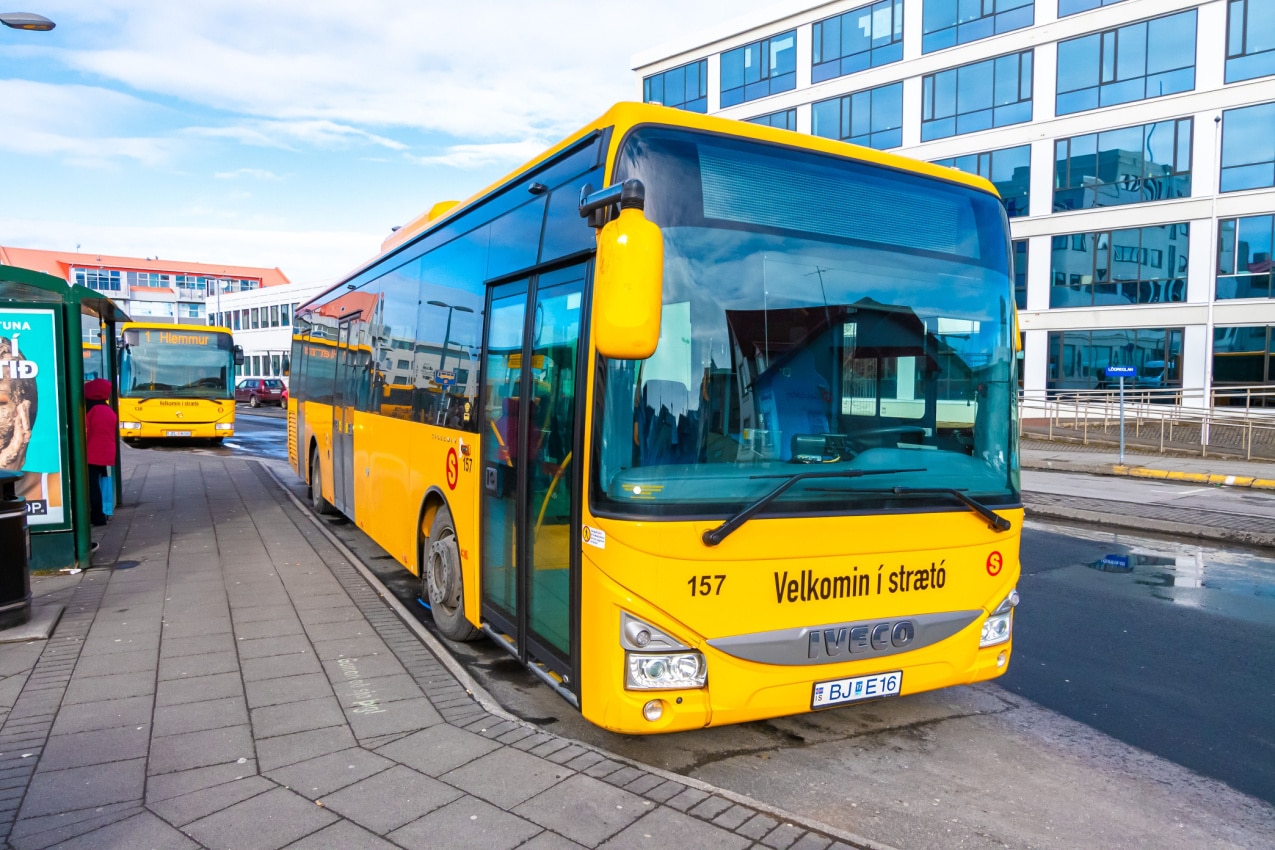
Iceland’s public transport is super safe—you’ll hardly ever feel uneasy as a tourist.
Iceland doesn’t have trains, so buses, called Strætó, are the go-to for public transport. From a crime perspective, buses are safe, but in winter or remote spots, they might not be as reliable, so keep that in mind. You can always visit the official Stræto website for schedules and tickets, and plan your adventures accordingly.
Taxis make for a great backup when buses aren’t available, but brace yourself—they’re pricier than Strætó. No Uber or Lyft here, but call local taxi companies like Hreyfill (+354 588 5522) and BSR (+354 561 0000) for a safe and reliable ride.
Ferries open up the possibility of island hopping, connecting major islands like Westman, Grímsey, and Flatey. While ferry rides are safe from theft concerns, remember that schedules vary by season, with more trips available in the summer (June-August)—remember to take a peek at the schedule before planning your trip!
Road Safety in Iceland
Iceland’s primary roads, like the Ring Road and Golden Circle, are well-maintained and safe for travel year-round. You can navigate these main routes with almost any type of vehicle.
However, keep in mind that some roads in Iceland are gravel, like the F-Roads, and require extra care. In certain areas, you might need to cross rivers without bridges, which can be risky for inexperienced drivers.
The main risk factor for dangerous roads in Iceland is the weather. High winds, storms, and snow can make even the safest road very dangerous—so stay up-to-date on weather reports and you’ll be fine. If you’re not experienced with F-Roads, stick to the main roads for a safer journey!
Medical Care Quality in Iceland
Iceland takes pride in offering top-tier medical care, with more doctors per capita than any other country on the planet. Almost all doctors are proficient in English. In Reykjavík and larger towns, hospitals are readily available, and even smaller towns boast at least one doctor and pharmacy.
Here are some of Iceland’s standout hospitals:
- Landspitalinn National University Hospital
- Primary Health Care of The Capital Area Clinics
- Nýtt Haskólasjúkrahús
- Reykjahlid Health Center
- Blonduos Hospital
For emergency situations, the Icelandic Association for Search and Rescue has set up bright orange emergency shelters in remote areas, coastline locations, as well as roads in high mountain passes. These shelters come stocked with essentials like food, fuel, and blankets.
While it’s reassuring to know that Iceland has a robust medical care system and emergency shelters for your well-being, getting travel insurance is a smart financial move. Medical expenses without travel insurance can get pricey.
Here are some insurance options:
- Travelex Insurance Services
- Faye
- Nationwide
- Seven Corners
- Trawick International
- Generali Global Assistance
- Berkshire Hathaway Travel Protection
- HTH Travel Insurance
Your health is a priority, and Iceland ensures that you are covered in both medical care and unforeseen situations in the wilderness.
Is It Safe to Travel Solo in Iceland?
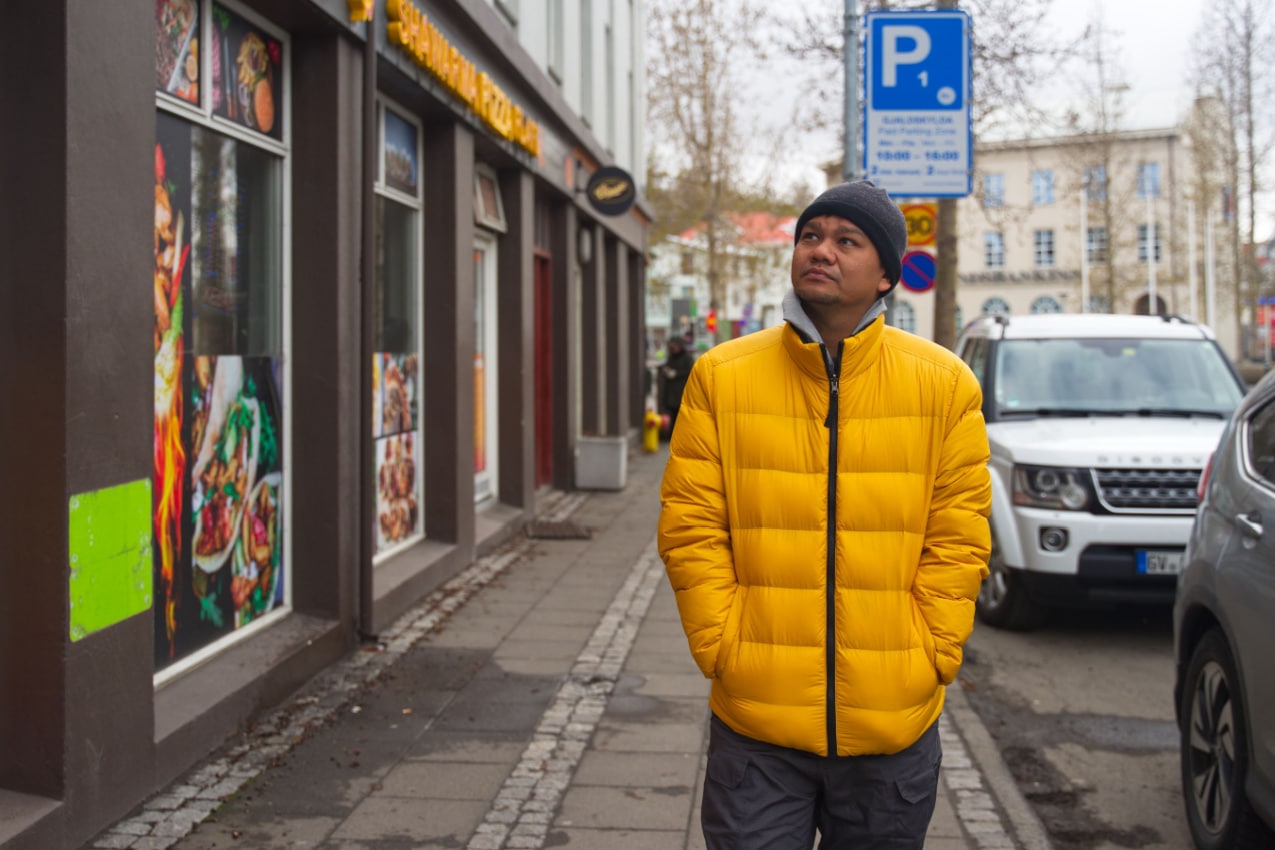
Yes, Iceland is the ideal destination for traveling solo. Not only is it the world’s safest country, but it also consistently ranks among the top five happiest nations globally. Combine the low crime rates with the heart-warming locals, and you’ll discover that solo travel in Iceland is remarkably stress-free.
Still, your vacation will be as safe as you make it—so responsible traveling is always advised. Be wary of your surroundings, keep an eye on your valuables, use GPS navigation so you don’t get lost, and don’t embark on solo adventures in nature!
Is It Safe to Travel to Iceland as a Family?
If there’s a spot on Earth where families can truly breathe easily, it’s Iceland.
Did you know that it’s a Nordic norm for parents to leave their peacefully sleeping babies outside while they pop into a restaurant or handle errands? Yes, that’s how safe locals feel about their country.
Turns out, infants that sleep outdoors tend to get better-quality sleep and are exposed to fewer germs than when they nap indoors. So if you are looking for a dream vacation with your little ones, Iceland is certainly a place where you can relax about your family’s safety.
Perils of Nature: The Risk of Natural Disasters in Iceland
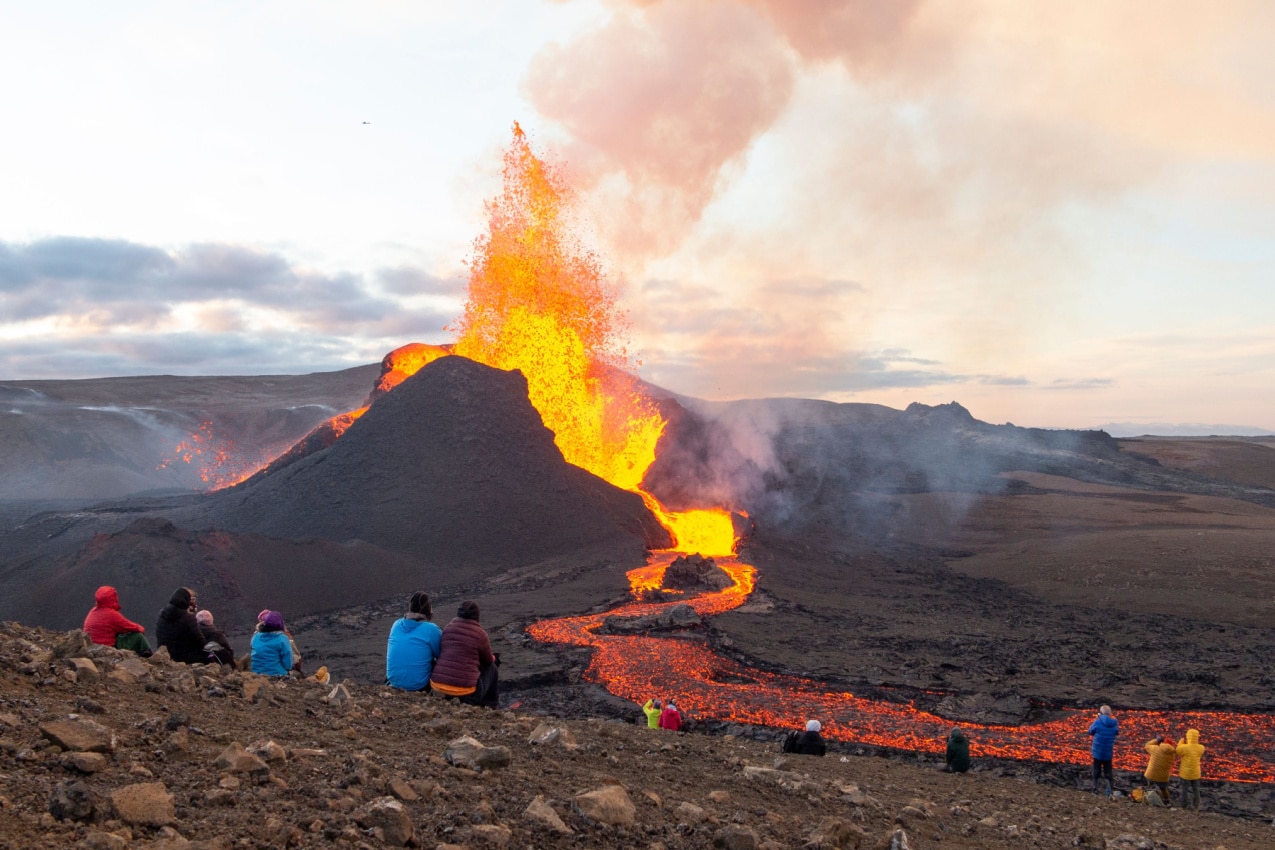
When venturing into the breathtaking Icelandic landscape, one needs to remain mindful of the ever-changing weather conditions and potential natural disasters.
Storms, floods, earthquakes, volcanic eruptions, landslides, and avalanches may strike with no warning. And although they’re rare, it’s essential to be prepared for the worst-case scenario. Let’s learn more.
Storms
Especially in winter, Iceland faces powerful storms bringing heavy rain, snow, and strong winds. As of December 2023, there are no severe weather warnings, but stay updated on forecasts and prepare for potential travel changes.
All in all, life in Iceland usually continues as normal during storms. The only thing to avoid is driving. Fatal accidents are uncommon, but getting stuck in snow is frequent, so opt to walk or stay indoors!
Shops, cafés, and museums also remain open. So unless there’s a super dangerous storm, feel free to layer up in warm clothes, go outside, and find a cozy spot in a café or restaurant or explore museums until the weather improves.
Floods
Floods in Iceland can result from heavy rainfall, rapid snowmelt, or glacial outbursts. The most recent flood occurred in August 2023 in the Skaftá River in South Iceland. According to the Icelandic Meteorological Office, the incident was due to a glacial outburst.
The good thing is that urban flooding isn’t common in Iceland, so this natural disaster should only concern you if you go to the specific areas where there’s an active flood. The flood-prone areas are usually well-monitored, but for the sake of your safety, avoid crossing or driving in affected locations.
Earthquakes
Iceland is one of the most seismically active regions on Earth. On November 9, 2023, the country experienced 1,400 earthquakes in 24 hours, followed by 800 more in the first 14 hours of November 10.
This recent seismic activity is localized in one part of the Reykjanes Peninsula, affecting Grindavík, the Blue Lagoon, and connecting roads—so if you are traveling to Iceland in the near future, it’s advisable to skip these areas that have the most active seismic activity.
In any case, structures in Iceland are designed to endure earthquakes with magnitudes as powerful as 7.0—so regardless of whether you’re staying at a hotel, hostel, or rental apartment, rest assured you’ll be safe.
In case of an earthquake, kneel, cover your head, and hold onto something sturdy, like a table or load-bearing wall. Avoid windows, as glass can break!
Volcanic Eruptions
Iceland, renowned for its volcanic activity, recently experienced a significant volcanic eruption on December 18 that was triggered by the numerous earthquakes mentioned earlier.
The eruption occurred north of the coastal town of Grindavík on the Reykjanes Peninsula, near the Blue Lagoon. While the lava is not flowing directly towards the town, authorities are closely monitoring the situation.
The eruption area is closed, Grindavík has been evacuated, and hiking in the area is prohibited. However, the rest of the country, including the capital Reykjavik, remains safe for visitors.
Travelers should respect the instructions of authorities and avoid hiking or driving in the affected area!
Landslides
Landslides in Iceland can be triggered by volcanic activity, heavy rainfall, or glacial melting. The most recent series of landslides occurred from December 15 to 18, 2020, in the town of Seyðisfjörður, resulting in the destruction of or damage to more than 10 buildings. Fortunately, there were no reported injuries.
Thankfully, landslides are not very common in other urban regions like the capital, Reykjavik. However, tourists should exercise caution when hiking, especially in areas with steep slopes.
Always stay on marked trails, pay close attention to warning signs, and steer clear of areas prone to rockfalls or landslides.
Avalanches
Exploring Iceland’s mountainous regions, especially during winter, may expose you to the risk of avalanches. On January 15, 2020, three avalanches struck in a single night—two in Flateyri and one in Súgandafjörður. Fortunately, there were no injuries, but the avalanches caused damage to boats and harbor structures in Flateyri and even triggered a flood in Súgandafjörður.
Iceland has implemented avalanche breakers along its mountainsides to mitigate the risk. These barriers serve a dual purpose: slowing down avalanches and breaking apart falling snow, thereby reducing the force of impact.
For tourists exploring snowy landscapes, stick to marked areas, carry avalanche beacons, and hike with local guides with avalanche expertise.
Beware the Silent Threat: Carbon Monoxide Poisoning in Iceland
Iceland hasn’t suffered any carbon monoxide poisoning, but that isn’t to say tourists shouldn’t be cautious of this deadly gas.
Carbon monoxide gas (CO) earned its nickname, the “silent intruder,” because it operates in stealth mode—no scent, no visible trace, and certainly no taste.
This gas usually seeps out from malfunctioning appliances, heating systems, and improper use of combustion devices. So if CO leaks in your hotel room from, let’s say, a malfunctioning water heater or stove, your senses won’t sound the alarm.
Once you inhale it, CO will cause nausea, dizziness, and eventually lull you into unconsciousness. Extended exposure to this unseen menace can lead to dire consequences, from paralysis and brain damage to the gravest outcome—loss of life.
Thankfully, ensuring a safe Iceland trip is well within reach with the help of CO detectors. These devices are ready to raise the alarm at the slightest hint of carbon monoxide. While it’s probable that most hotels or rental apartments in Iceland are already equipped with these safety measures, it’s always wise to verify with the staff.
For an added layer of safety, consider bringing a portable CO detector along.
Serenity by the Shore: The Safety of Iceland Beaches
Iceland’s 3,000+ miles (4,800 km) of coastline boast some of the world’s most stunning beaches—but despite their beauty, not all of them are safe for swimming.
The powerful currents and unexpected “sneaker” waves on Icelandic beaches have tragically led to several fatal incidents. The most recent incident occurred in 2022 on Reynisfjara Beach, the country’s most famous but dangerous beach, when a man entered the sea against safety advice and lost his life. Sadly, it marked the fifth fatality of its kind in seven years.
While Reynisfjara stands out as the most notorious, it’s crucial to exercise caution when swimming in the sea anywhere in Iceland. Other popular beaches in the country, including Dritvík, Búðir, Skarðsvík, Nauthólsvík, Grotta, Dyrhólaey, Djúpalónssandur, Sólheimasandur, Diamond Beach, Vestrahorn, Breiðavík, and Red Sand beach, also pose potential risks from such sneaky waves.
Local authorities emphasize a key rule for beach visitors: “Never turn your back on the waves.” Each beach features official warnings and safety flags, so appreciate the beauty of Iceland’s beaches, but don’t engage in risky behavior that could jeopardize your life.
Iceland Weather Patterns: What to Expect
The climate of Iceland captures the real essence of Nordic weather, with slight differences across the island’s many regions. The south coast enjoys a milder and wetter climate compared to the north, where winter brings more frequent snowfall and extremely low temperatures.
For the purposes of this discussion, let’s delve into the character of Iceland’s capital, Reykjavik. Summers in Reykjavik are brief, cool, and often overcast, while winters are very cold, with abundant snow and brisk winds. Across the year, temperatures fluctuate between 28°F and 57°F (2.2°C and 13.8°C)—but rarely dip below 17°F (8.3°C) or rise above 62°F (16.6°C).
The warm season lasts from June to September, with an average daily temperature of 53°F (11.7°C). July enjoys the pinnacle of warmth, with an average high temperature of 56°F (13.3°C).
The colder season spans November to April, marked by average daily high temperatures below 40°F (4.4°C). January, Reykjavik’s chilliest month, witnesses an average low of 28°F (2.2°C) and a high of 36°F (2.2°C).
Reykjavik’s cloud-free season extends from April to November, with May standing out as the clearest month, offering about 42% clear skies. The rest of the months succumb to cloudiness, with January being the gloomiest with approximately 77% cloud cover.
Rainfall graces Reykjavik from the end of August to April, peaking in September with an average of 4.5 inches (114 millimeters). The dry season, stretching from April to the end of August, sees minimal rainfall, with June experiencing the least at 2.2 inches (55 millimeters).
Snow covers Reykjavik from late October to the end of April. January is the snowiest month with an average snowfall of 9.9 inches (251 millimeters). July remains virtually snow-free, at 0.0 inches.
Winds whip through Reykjavik from late October to the end of April, with January claiming the title of the windiest month, boasting an average hourly wind speed of 15.9 mph (25.5k/h). In contrast, July enjoys relative calmness with an average hourly wind speed of 8.0 mph (k/h).
The optimal period to visit is from June to mid-September. August is the best month in terms of swimming weather, showcasing the warmest waters with an average temperature of 52°F (11.1°C). Conversely, March sees the coolest water temperatures, averaging around 41°F (5°C).
Monthly Average Temperatures in Reykjavik
| Month | Fahrenheit (°F) | Celsius (°C) |
| January | 32 | 0 |
| February | 33 | 0.5 |
| March | 34 | 1.1 |
| April | 38 | 3.3 |
| May | 44 | 6.6 |
| June | 50 | 10 |
| July | 53 | 11.6 |
| August | 52 | 11.1 |
| September | 47 | 8.3 |
| October | 40 | 4.4 |
| November | 36 | 2.2 |
| December | 33 | 0.5 |
When Is the Best Time to Visit Iceland?
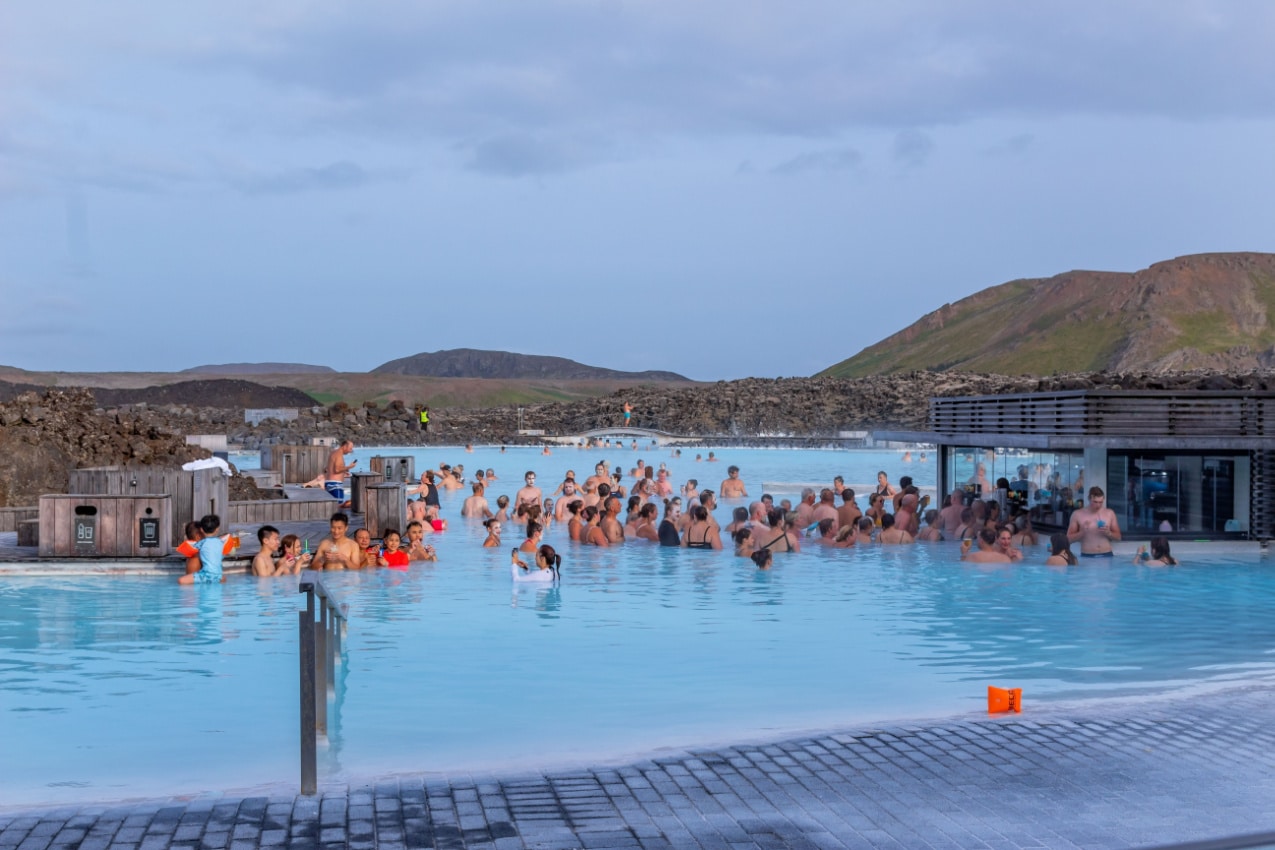
Summer and winter are the best seasons to visit Iceland. In summer, Iceland comes alive thanks to the warmer temperatures and the beautiful phenomenon of the midnight sun — casting long days of sunlight. On the flip side, winter is ideal for chasing the mystical Northern Lights or seeking solace in the renowned geothermal spas.
However, if your travel agenda revolves around specific things, such as whale migrations, then careful timing becomes crucial. Consider these pointers:
Best time to visit the Blue Lagoon (summer & winter): The geothermal spas welcome visitors year-round, but the experience is the most enjoyable in the summer when the weather is warm, and in winter, when the crowds thin out and the hills are covered in snow, creating a magical sight to enjoy while soaking in the steaming waters.
Best time to immerse yourself in Icelandic waters (summer): For a refreshing dip, opt for June to mid-September. August stands out as the pinnacle, boasting the warmest waters at an inviting 52°F (11.1°C).
Best time for whale watching (mid-spring to the beginning of fall): Iceland’s coastal waters host a captivating array of whales. The prime window for whale watching spans April to September when these majestic creatures migrate north for the summer.
Best time to grab the best deal (late fall through early spring): Wallet-friendly options peak during the off-season (excluding December). This period often presents cost-saving opportunities, as the summer and winter holiday season tends to be both crowded and more expensive.
Best time to enjoy fewer crowds (late fall through early spring): The off-season is also when you’ll escape the tourist throngs and embrace tranquility in Iceland. Daylight dwindles, but instead, you get a serene ambiance perfect for frequenting hot springs and witnessing the mesmerizing northern lights. Be cautious during the holiday season in December, as tourism sees a resurgence!
Best time to enjoy good weather (summer): For optimal weather, visit Iceland during July and August. June comes with 24-hour daylight, providing endless opportunities for outdoor activities. Despite occasional rain and intense winds, these summer months offer the warmest temperatures and the longest daylight hours.
How to Stay Safe in Iceland
- SafeTravels offers a wealth of information crucial for Iceland—the latest weather updates, road conditions, safety tips, a free app, and a glimpse into ICE-SAR (Icelandic Association for Search and Rescue) teams
- Sign up for SafeTravels’ free SMS service to get immediate notification in case of drastic weather changes, bad road conditions, or natural destructions
- Distances between gas stations may vary, so plan your refueling accordingly
- Reduce speed before encountering the change in the road surface to maintain control
- F-Roads are open for summer exploration only—a 4×4 jeep-type vehicle with ample ground clearance is essential
- Don’t venture into snow-covered mountains without checking the weather first
- Forecasts like Vedur.is or Wet.is provide real-time weather updates
- If you’re hiking, grab a GPS, map, and compass
- For biking in the highlands, opt for a full or half-suspension mountain bike
- Dress warm and waterproof—check SafeTravel’s tips for outdoor clothing
- If you’re new to camping, maybe rethink it due to the ever-changing weather—if you still want to give it a try, check SafeTravel’s camping tips
- Stick to marked paths in geothermal areas
- Don’t climb on glaciers at Jokulsarlon Lagoon
- Watch out for slippery spots, and make sure your shoes have a good grip
- If you’re planning to explore the great outdoors, pack some water, snacks, blankets, and a portable battery charger
- Be careful on Reynisfjara’s black-sand beaches, those waves can be sneaky—so stay close to the shore
Emergency Numbers
- Urgent police, fire, or emergency assistance:112
- Search and Rescue: 570-5900
- Reykjavik Police Station: 444-1000
FAQ
Iceland boasts top-notch air quality. According to the World Air Quality Index, Iceland ranks sixth globally for the best air quality. So, you’ll not only be safe but also breathe some of the freshest and cleanest air on the planet. BBC reveals that Nordic families, including those in Iceland, leave their babies outside to sleep for a couple of hours for this sole reason — to expose them to this incredibly fresh and healthy air, fostering a robust immune system in the process.
Icelandic tap water is not only safe to drink but also ranks as one of the best in the world. It’s tied for the top spot with the United Kingdom, Netherlands, Greece, Switzerland, and several others countries.
An impressive 95% of all water in Iceland comes from springs and is free of chlorine, calcium, and nitrate. The quality of tap water throughout Iceland is routinely monitored and tested. In Reykjavík, the water quality is frequently measured to ensure it consistently meets the highest standards. So feel free to take a sip.
Rest assured, Iceland is home to no dangerous animals. The most potentially “dangerous” creature is the Arctic fox. While these foxes are not inherently aggressive, it’s best to avoid attempting to pet them – they’re wildlife, after all. Additionally, be cautious while driving as sheep, cows, or reindeer may cross the road.
Other than that, you won’t have any dangerous encounters like you would in other places in the world — like the deadly spiders in New Zealand, or sharks and alligators in Mexico.
Enjoy the Land of Fire and Ice!
Iceland, home to Sigur Rós, Björk, and the fictional Fire Saga, is the safest country globally to explore—however, it’s crucial to stay cautious, even in the safest place!
Watch out for potential pickpockets, bring warm clothes, check the local news for potential weather disruptions or volcanic eruptions, and most importantly—always trust guides and signs that warn of potential dangers when you’re exploring the wild.
Feeling excited for your trip to the land of fire and ice? The ideal time for visiting this destination would be in summer, if you like to witness the midnight sun—or in winter, for the beautiful northern lights.
Safe travels!

